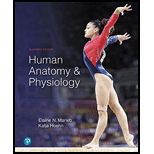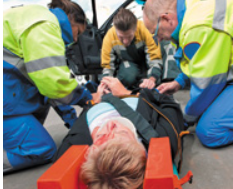
52-Year-Old Male with Multiple Sclerosis
Mr. Ayers was diagnosed with an aggressive form of multiple sclerosis 18 years ago. His illness has not responded to conventional treatments so he's been referred to your clinic for a clinical trial.
The doctor explains that his treatment will involve giving Mr. Ayers a drug that will release stem cells from his bone marrow so they can be collected from his blood. Then Mr. Ayers will be given (1) drugs that will destroy the blood-forming cells in his bone marrow, and (2), antibodies against his T lymphocytes. Finally, the stem cells that were collected from him will be used to repopulate his bone marrow.

The doctor says, “This treatment avoids problems, such as transplant rejection, that are associated with other kinds of transplants.”
3. NCLEX-STYLE The nurse explains to Mr. Ayers that a bone marrow transplant from another donor could result in the transplanted immune cells attacking his own cells. The best explanation for this
is:
a. Transplants from another person are never perfect matches. Any organ transplant could cause this problem.
b. A donor transplant would be a problem because Mr. Ayers's own immune system will be destroyed, so he wouldn't be able to fight off mismatched cells from a donor transplant.
c. Bone marrow is where immune cells are made. If Mr. Ayers received mismatched immune cells, these cells could attack his body.
d. Because Mr. Ayers has an autoimmune disorder, his body will attack anything transplanted into it.
Want to see the full answer?
Check out a sample textbook solution
Chapter 21 Solutions
EBK HUMAN ANAT.+PHYSIOLOGY
- Plating 50 microliters of a sample diluted by a factor of 10-6 produced 91 colonies. What was the originalcell density (CFU/ml) in the sample?arrow_forwardEvery tutor here has got this wrong, don't copy off them.arrow_forwardSuppose that the population from question #1 (data is in table below) is experiencing inbreeding depression (F=.25) (and no longer experiencing natural selection). Calculate the new expected genotype frequencies (f) in this population after one round of inbreeding. Please round to 3 decimal places. Genotype Adh Adh Number of Flies 595 Adh Adh 310 Adhs Adhs 95 Total 1000 fladh Adh- flAdn Adh fAdhs Adharrow_forward
- Which of the following best describes why it is difficult to develop antiviral drugs? Explain why. A. antiviral drugs are very difficult to develop andhave no side effects B. viruses are difficult to target because they usethe host cell’s enzymes and ribosomes tometabolize and replicate C. viruses are too small to be targeted by drugs D. viral infections usually clear up on their ownwith no problemsarrow_forwardThis question has 3 parts (A, B, & C), and is under the subject of Nutrition. Thank you!arrow_forwardThey got this question wrong the 2 previous times I uploaded it here, please make sure it's correvct this time.arrow_forward
- This question has multiple parts (A, B & C), and under the subject of Nutrition. Thank you!arrow_forwardCalculate the CFU/ml of a urine sample if 138 E. coli colonies were counted on a Nutrient Agar Plate when0.5 mls were plated on the NA plate from a 10-9 dilution tube. You must highlight and express your answerin scientific notatioarrow_forwardDon't copy off the other answer if there is anyarrow_forward
 Human Heredity: Principles and Issues (MindTap Co...BiologyISBN:9781305251052Author:Michael CummingsPublisher:Cengage Learning
Human Heredity: Principles and Issues (MindTap Co...BiologyISBN:9781305251052Author:Michael CummingsPublisher:Cengage Learning Medical Terminology for Health Professions, Spira...Health & NutritionISBN:9781305634350Author:Ann Ehrlich, Carol L. Schroeder, Laura Ehrlich, Katrina A. SchroederPublisher:Cengage Learning
Medical Terminology for Health Professions, Spira...Health & NutritionISBN:9781305634350Author:Ann Ehrlich, Carol L. Schroeder, Laura Ehrlich, Katrina A. SchroederPublisher:Cengage Learning Biology 2eBiologyISBN:9781947172517Author:Matthew Douglas, Jung Choi, Mary Ann ClarkPublisher:OpenStax
Biology 2eBiologyISBN:9781947172517Author:Matthew Douglas, Jung Choi, Mary Ann ClarkPublisher:OpenStax Biology: The Unity and Diversity of Life (MindTap...BiologyISBN:9781305073951Author:Cecie Starr, Ralph Taggart, Christine Evers, Lisa StarrPublisher:Cengage Learning
Biology: The Unity and Diversity of Life (MindTap...BiologyISBN:9781305073951Author:Cecie Starr, Ralph Taggart, Christine Evers, Lisa StarrPublisher:Cengage Learning





